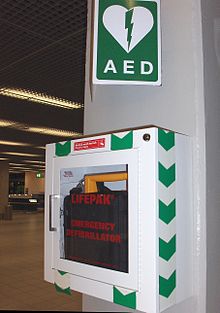First Aid/Automated External Defibrillation
Introduction — Issues in Providing Care — Primary Assessment & Basic Life Support — Secondary Assessment — Circulatory Emergencies
Respiratory Emergencies — Soft Tissue Injuries — Bone & Joint Injuries — Environmental Illness & Injury
Medical Conditions & Poisoning — Advanced Topics — Appendices — Meta content
| A Wikibookian suggests that Transwiki:Automated external defibrillator be merged into this chapter. Discuss whether or not this merger should happen on the discussion page. |
Defibrillation is an essential part of resuscitation. Survival chances of a fibrillating victim (ventricular fibrillation or ventricular tachycardia) start at 90% if defibrillated immediately and decrease by 10% every minute. Should a victim be in cardiac arrest and require defibrillation, it is crucial that EMS is called immediately.
Defribrillation operations start by exposing the chest, and removing all metallic items American red Cross says: "■ Jewelry and body piercings: You do not need to remove jewelry and body piercings when using an AED. Leaving them on the victim does no harm. However, do not place the AED pads directly over metallic jewelry or body piercings. Adjust AED pad placement if necessary" Prior to the application of the defibrillation pads, shaving the chest of exceptionally hairy victims is advised to increase conductivity to the chest and reduce the chance of burns, though shaving the chest should only be performed if a razor is readily available and will not delay defibrillation by more than 20 seconds. It is also crucial that you remove any patches (especially medicine and nicotine) on the person's chest while wearing gloves to ensure the shock will not be interrupted by having to go through these patches. Failure to remove nicotine patches can result in a fire.
Now turn on the defibrillator unless it automatically turns on once you open it. Most AED units will give clear voice instructions; follow the prompts. Once the chest is exposed, you are to place the electrodes: one on the left side, under the arm, and the other over the right breast. The location of pad placement is clearly depicted on each pad; they must go exactly as shown in the picture. Once connected, the defibrillator will automatically start monitoring the heart's electrical activity to determine whether a shock is appropriate. Some defibrillators require the user to press an analyze button before the machine will analyze the heart rhythm. The machine will clearly talk you through all steps of the process.
CPR must be stopped while the defibrillator is monitoring the victim's heart activity. In all cases, defibrillation has priority over CPR. Do not touch the victim or the AED - if you do, you could interfere with the analysis.
If the AED advises a shock, the operator will say "I'm Clear, you're clear, we're all clear" while ensuring that the operator is not touching the victim or standing in a wet environment next to the victim that could conduct electricity through the rescuer. The AED operator is also making sure that all other people surrounding the victim are clear. The final "we are all clear" ensures a double check to ensure that everyone is away from the victim. If the victim is being given oxygen supplementation, the equipment must be removed at this point. The AED will shock the victim; the operator may be required to press a shock button. Touching the victim is potentially fatal when the shock is administrated. After the shock has been delivered, it is safe to touch the victim; no electricity will remain in them. The defibrillator will advise you what to do next - usually you'll be told to begin chest compressions and rescue breaths again.

Defibrillators can also be used for monitoring and recording purposes; a different set of electrodes is available on some defibrillators for cardiac monitoring, though most defibrillators have the cardiac monitoring located within the pads. Because cardiac monitoring (ECG) is an advanced skill, it will not be covered in this section. Should fibrillation occur when the monitoring patches are on, the defibrillator will ask the operator to change patches, though most automatically analyze the patient through the two main patches every 2 minutes or whenever the analyze button is pressed.
Note: Defibrillators are often quite graphically pictured in films and television shows. Actually, defibrillation might induce some contractions in the muscles of the patient, but in no case will the patient jump. In most television shows, the paddles are used which may make a rescuer feel apprehensive about defibrillating a patient if they believe that they have to gel the paddles then rub them together before shocking the patient. All AEDs used in the public access setting have two pre-gelled patches that are easily placed onto the patient's skin. This keeps the rescuer at a further distance from the patient during the shocking and enables the patches to stay on continuously during the resuscitation efforts.